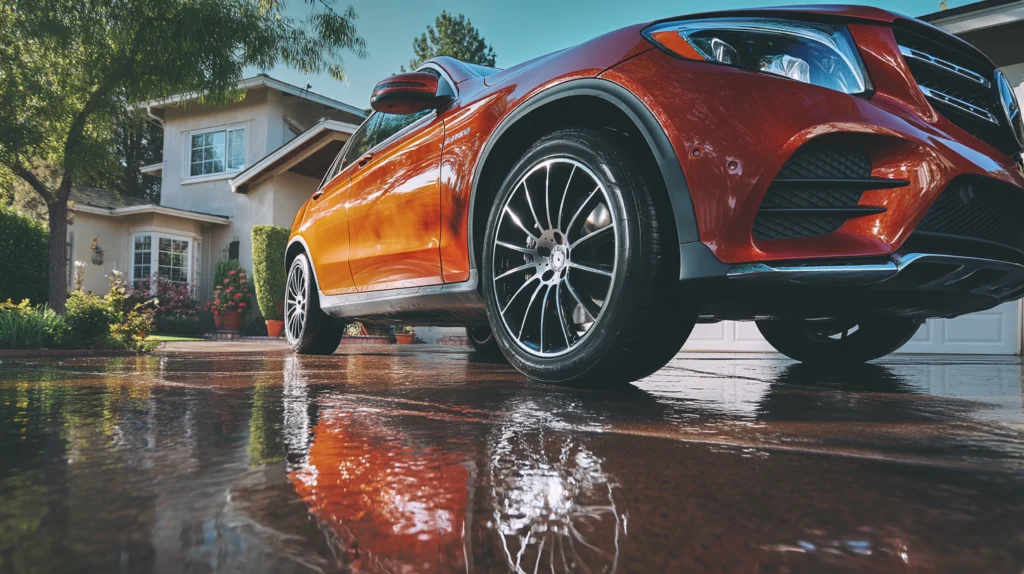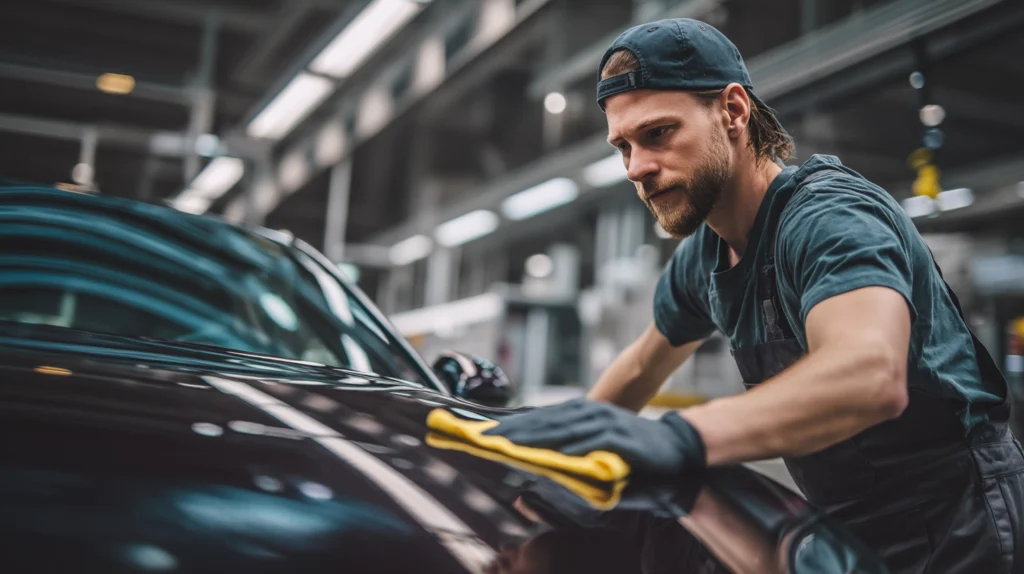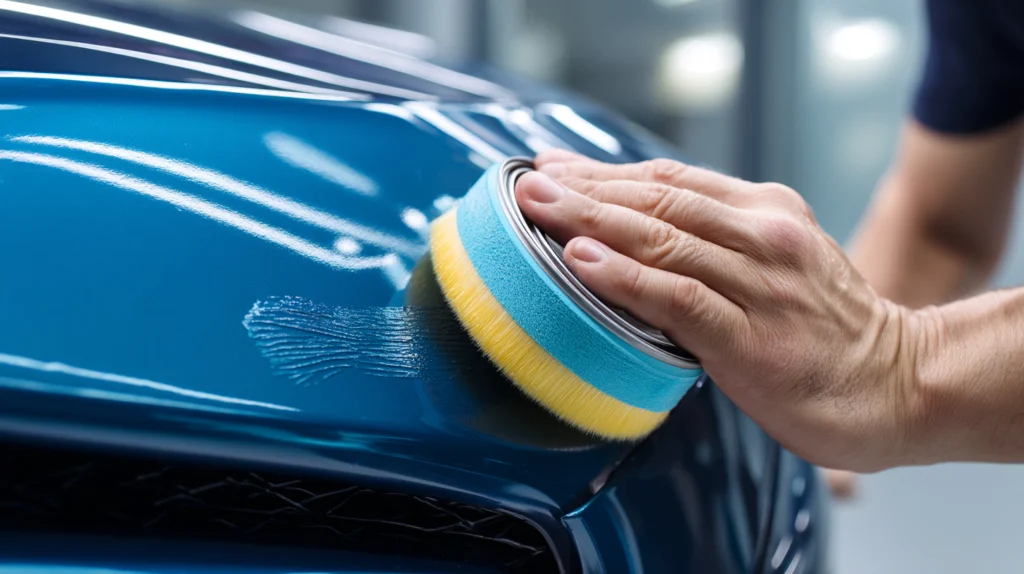A Complete Guide for Today’s Drivers
Car paint can feel surprisingly vulnerable, even when you do everything right. One moment your vehicle looks clean and glossy, and the next you notice paint scratches that seem to appear out of nowhere. Many drivers wonder how does car paint get scratched, especially when they take pride in keeping their vehicles in good condition. The truth is that car paint scratches come from countless everyday sources, and most of them happen so quickly that you never see the moment of impact. At Re-Lux Collision, we help drivers repair everything from minor scratches to deep scratches that reach primer or bare metal. We understand how these scratches form, why modern car paint is more sensitive, and what you can do to protect the finish. If your car already has visible marks, our team is ready to help with accurate color matching, proper refinishing, and trusted car scratch repair.
How Modern Car Paint Works, And Why Scratches Happen

The Multi Layer Paint System
Today’s cars use a complex paint system made from three layers or more. Each layer plays a different role in appearance and protection. The clear coat sits on top and provides gloss, depth, and protection. The color coat or base coat provides your car’s paint color. Below the color coat is the primer, which helps paint bond to the metal and prevents corrosion. When scratches occur, the layer they reach determines what kind of repair is needed. Light car scratches usually affect only the clear coat. Moderate paint scratches may reach the color coat. Deep scratches cut into primer and sometimes expose bare metal.
Why Modern Paint Seems Easier to Scratch
Many drivers with a new car or updated paint job notice that the finish feels softer than older vehicles. Modern paint technology uses more environmentally friendly formulas, which can be more delicate. These coatings look great on black cars, white cars, and every color in between, but they are more vulnerable to car scratches from improper washing techniques, other sharp objects, and daily wear. This is why using a clean microfiber towel, a microfiber cloth, and even a grit guard during every wash matters more than ever.
Scratch Depth Matters More Than Scratch Length
A long scratch on the surface may not be serious if it affects only the clear coat, while a short scratch that reaches the color coat or primer may require refinishing. If you can feel the scratch with your fingernail, it is usually deeper than the clear coat. If you see gray or white, that may indicate primer scratches. If silver or exposed metal is visible, the damage needs immediate attention to prevent rust and further damage.
Common Everyday Causes of Car Paint Scratches

1. Road Debris and Rock Chips
Road debris is one of the biggest causes of car paint scratches. Sand, gravel, loose asphalt, and other debris fly up from tires, especially during heavy traffic or when traveling behind other vehicles. Gravel roads increase the risk even more. These small impacts create tiny chips and scratches in the clear coat and sometimes into the base coat. Areas like the hood, bumper, roof edges, and lower panels get hit most often. Even small scratches can expand if water enters the damaged surface and causes rust beneath the paint.
2. Parking Lots and Tight Spaces
Parking lots are one of the most common places where car scratches occur. Tight spaces make it easy for other drivers to swing car doors open and create door dings that scratch your car’s paint. Shopping carts roll across parking lots and rub against bumpers. Careless drivers may scrape along your vehicle while trying to park. A minor collision in a crowded parking lot often produces paint scratches even if the impact is slow and the surface looks slightly scratched rather than dented. When other cars rub against your doors or panels, the damage can transfer paint, leave deep scratches, or create multiple small scratches across the surface.
3. Automatic Car Washes and Swirl Marks
Automatic car washes are quick and inexpensive, but they are a common cause of swirl marks, micro scratches, and clear coat scratches. Brushes and cloth strips can trap dirt and grit from hundreds of vehicles. As they rub across your car’s finish, they drag dirt across the clear coat and leave circular marks. Black cars show these swirl marks more easily, but every color is affected. Even touchless washing still creates risk if you dry the vehicle with dirty sponges or towels.
4. Improper Washing or Drying at Home
Improper washing is a major cause of car paint scratches. Wiping a dusty car, using dirty sponges, scrubbing with household cloths, or skipping proper washing techniques can leave scratches across the surface. If you wash your vehicle with a sponge that has trapped dirt, it becomes a sharp object that cuts into the clear coat. Using a clean microfiber towel is essential when drying, because even tiny debris can scratch the surface while you wipe the panels.
5. Weather Related Scratching
Weather brings seasonal risks for paint scratches. During winter, removing snow with stiff brushes, plastic scrapers, or hard bristles can leave clear coat scratches across the hood, roof, and windshield edges. Snow often packs in dirt, which grinds against the surface. In summer, bird droppings, hardened tree sap, and bug residue can etch the clear coat. Once the surface softens, wiping it can leave new scratches. This is especially noticeable on a new car or a vehicle with a soft paint job.
6. Human Contact
Everyday contact is another significant factor. Keys, bags, backpacks, bicycles, sports equipment, and other sharp objects can create car paint scratches. Rubbing against the vehicle while moving around a garage can also damage the paint. Children riding too close, pets brushing against the sides, or loading heavy items into the trunk can leave minor scratches or deep scratches depending on the pressure.
7. Vandalism or Intentional Damage
Sometimes paint scratches come from intentional damage. A key or sharp object dragged across a panel can cut through the clear coat, the color coat, and the primer. These scratches nearly always require a full car scratch repair with sanding, priming, refinishing, and blending.
Environmental and Chemical Factors That Lead to Scratching

Bird Droppings, Sap, and Bug Residue
Bird droppings and tree sap contain acids that damage the clear coat. If these contaminants sit on the surface too long, they soften the clear coat and leave permanent marks. When you try to wipe them off, the weakened surface scratches easily.
Gasoline, Brake Fluid, and Harsh Chemicals
Spilled gasoline, brake fluid, or harsh cleaners can remove protective oils from the clear coat. Once the finish becomes dry or brittle, even minor rubbing can create scratches or peeling.
UV Exposure and Temperature Swings
Constant sunlight breaks down clear coat over time. Hot and cold cycles expand and contract the paint, which weakens the surface and increases the risk of scratches. Black cars absorb more heat and may show damage faster on older paint jobs.
Types of Car Paint Scratches, And How to Identify Them
Light Clear Coat Scratches
These scratches look like swirl marks, haze, or faint lines. They usually affect only the surface and can often be corrected with professional polishing or paint correction. Using a ceramic coating afterward helps protect against micro scratches.
Moderate Scratches Into the Color Coat
These scratches reach the color coat and create a more visible line. They often occur from tree branches, overhanging branches, road debris, or minor contact in parking lots. These usually require refinishing or blending to restore a smooth surface.
Deep Scratches Into Primer or Metal
If a scratch exposes primer or bare metal, it must be repaired quickly to prevent rust. Deep scratches from a sharp object or a minor collision require sanding, priming, and a full paint repair. Touch up paint may help protect the damaged area temporarily, but full refinishing ensures a smooth, durable finish.
Can You Prevent Scratches, Practical Tips That Actually Work

Use Safe Washing Methods
Use proper washing tools to protect the finish, including a microfiber cloth, a clean microfiber towel, pH balanced soap, and a grit guard bucket to trap dirt. Avoid improper washing techniques that cause scratches.
Protective Coatings and Films
A ceramic coating adds resistance to minor scratches and makes washing easier. Paint protection film prevents chips from road debris and sharp objects. Car covers can also protect your vehicle’s paint when parked outdoors.
Smart Parking Habits
Avoid parking too close to other vehicles, door dings, and shopping carts. Park a safe distance away from tight spaces and choose wider spots when possible. Parking inside a garage also protects the car’s paint from weather and other debris.
Seasonal Care
In winter, be gentle when removing snow and avoid using sharp plastic edges. In summer, remove bug residue, tree sap, and bird droppings quickly to protect the clear coat.
When Should You Repair Car Paint Scratches
Signs a Scratch Needs Professional Attention
You should schedule repair when you see exposed metal, primer scratches, spreading paint damage, peeling edges, or if you can feel the scratch with your fingernail. Deep scratches may cause rust if left untreated.
Why Timing Matters
Scratches allow moisture to enter the paint layers. This can create rust, peeling, and further damage. Early repair helps protect the car’s finish and preserve the value of your vehicle.
How Re Lux Collision Handles Scratch Repair
Our team uses professional tools, precision color matching, durable refinishing products, and high quality repair techniques to restore the paint. We correct clear coat scratches, repair deeper damage, blend new paint smoothly, and help with insurance claims when needed. If you need trusted scratch repair from a local body shop, we are here to help.
FAQs, Car Paint Scratches
What Causes the Most Car Paint Scratches?
Road debris, improper washing, automatic car washes, tight spaces, bird droppings, tree branches, and contact from other vehicles or careless drivers.
Why Does New Car Paint Scratch Easily?
Modern clear coat formulas are softer and more sensitive to dirt, dust, and washing marks.
Can Automatic Car Washes Scratch Paint?
Yes, the brushes hold dirt that can create swirl marks and micro scratches.
Can I Remove Scratches Myself?
Minor scratches may be improved with touch up paint or polishing, but deeper scratches need professional repair.
Do Ceramic Coatings Prevent Scratches?
They reduce micro scratches but do not stop impacts from road debris or sharp objects.
When Is Repainting Necessary?
If you see exposed metal, primer scratches, or color coat damage, repainting is usually required.
What Should I Do After Seeing a Scratch?
Clean the area gently, avoid rubbing, and schedule an inspection to prevent further damage.
Will Insurance Cover Scratches?
If the scratches result from a covered incident such as a minor collision or vandalism, insurance may help.
Final Takeaway, Protecting Your Vehicle’s Paint For The Long Run
Most car scratches come from everyday driving, road debris, parking lots, improper washing, automatic car washes, and weather exposure. With the right habits, you can protect your car’s paint and reduce long term wear. When damage does occur, repairing it early prevents rust, improves appearance, and keeps your vehicle looking its best. If your car has scratches of any kind, our team at Re Lux Collision is here to help with professional refinishing and scratch repair. Contact us today to schedule your free estimate.




